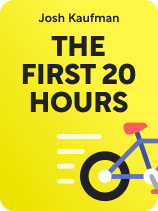

This article is an excerpt from the Shortform book guide to "The First 20 Hours" by Josh Kaufman. Shortform has the world's best summaries and analyses of books you should be reading.
Like this article? Sign up for a free trial here.
What skill do you want to learn? How should you go about choosing among the countless options?
Skill acquisition expert Josh Kaufman provides a step-by-step process for mastering the basics of any new skill with only 20 hours of practice. His system favors efficiency, so the first step is to choose a skill wisely and then attach a specific goal to it.
Continue reading to learn how to take the first step toward learning a new skill in a way that sets you up for success.
What Skill Do You Want to Learn?
You’ve decided you want to pick up a new skill. So, what skill do you want to learn? Kaufman suggests you choose the skill you’re most excited about. The more interest you have in a skill, the more motivated and focused you’ll be and the faster you’ll improve.
(Shortform note: Interest is a state of engagement that acts as an “approach urge”—it encourages you to approach new things. It also counteracts your “avoid urges,” which compel you to stick to what’s safe and familiar. In other words, when you’re interested in a skill, you’re more driven to engage with it as opposed to procrastinating or avoiding it altogether. Interest enhances learning because it affects how you feel and think. It makes you feel energized and captivated. You also pay closer attention to things, process information more efficiently, and can work harder and longer on the task at hand.)
Kaufman advises against trying to learn multiple new skills at the same time. Acquiring skills requires focus and concentration, and switching between different skills distracts you and slows down your progress. Concentrating your time and energy on one skill allows you to improve as fast as possible.
(Shortform note: While multitasking might feel productive, it actually increases the time you spend on a task by a significant amount. In Eat That Frog!, Brian Tracey explains that people can only focus on one thing at a time. Once you switch your attention to something else, you need 17 minutes to fully refocus on the task you’ve been working on. Thus, by concentrating on one skill without interruption, you’ll be able to learn it in half the time than if you switched between multiple skills.)
Once you’ve chosen the skill you want to acquire, set a goal for how proficient you want to become. To do this, Kaufman suggests you ask yourself why you want to learn the skill in the first place. Be specific and describe what you hope to accomplish with the skill so you can focus on practicing the aspects of it that are most relevant to your goal. For example, if you want to learn how to bake so you can make homemade cookies to share with friends and family, your goal could be to successfully bake three types of cookies from scratch.
(Shortform note: Other experts recommend making your goal clear and specific enough to visualize what it looks like when you achieve it. In The Rise of Superman, Steven Kotler says being able to imagine yourself accomplishing your goals improves your focus and performance. This is because visualization activates the same neurons in your brain that fire when you actually perform the action. Thus, by having clear goals you can visualize, you’re preparing your brain to make them happen.)
Kaufman suggests you avoid aiming too high when deciding your goal. Ideally, the goal should be just out of reach. He explains that the more relaxed your goal is, the more quickly you can reach it and acquire the skill. Hitting your goal doesn’t have to signal the end of your skill-building—you can continue to practice and progress more if you’re still interested.
(Shortform note: In Atomic Habits, James Clear provides advice that expands upon Kaufman’s. Clear explains that you should make it easy to start a new behavior, but then you must increase the difficulty to keep yourself challenged and engaged. He specifies that you should set a goal that’s 4% harder than what you’re currently able to do. In order to do so, make sure your goal has a 50/50 chance of success or failure. This way, you achieve the right balance of success and failure to stay motivated.)

———End of Preview———
Like what you just read? Read the rest of the world's best book summary and analysis of Josh Kaufman's "The First 20 Hours" at Shortform.
Here's what you'll find in our full The First 20 Hours summary:
- A simple and effective method for learning almost any skill in 20 hours
- The misconceptions that hold us back from learning new skills
- Actionable tips to help you optimize your skill-building experience






